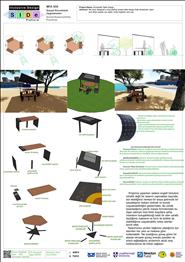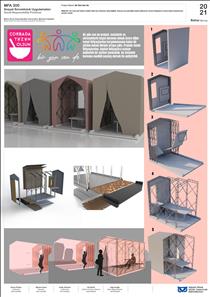Accessible Picnic Table

DESIGNED BY:
Kevser Başaran, Kadir Gök, Mehmet Ali Temizel, Tuğçe Akgün (SCPAT)
INTRODUCTION:
At the beginning of our project, which focuses on the issue of participation in social life, we have come together with our NGO partner from The Spinal Cord Paralytics Association of Turkey and identified problems related to the use of wheelchairs in the light of individual and observational experiences. It was observed during these meetings that the expressed difficulties exist both in the house and in public spaces, and these are mostly ignored by the majority of people. The fact that it is impossible to walk along a street without any obstacles due to use of wrong ramps, cars parked at the beginning of ramps, damaged roads, and fluctuations in elevation, using stairs due to the lack of ramps in most places in Istanbul are some of the issues we have identified with our NGO partner. Our NGO partner has stated that wheelchair users have difficulty in participating in public life because of these problems.
Following our meetings held to open the design brief we are focusing on; we have decided to develop a sample urban arrangement as a solution approach, and the issue has been discussed in detail. After the meetings we had with our NGO partner and the academics responsible for the Social Responsibility Practices course, we have narrowed down our project's scope and decided to focus on one public product that poses a current problem. Accordingly, with the guidance of NGO design partner, picnic tables used in public areas were determined as the scope of our project.
AN ACCESSIBLE PICNIC EXPERIENCE:
When we mentioned our NGO design partner about what we wanted to do for socialization points in public areas, she has informed us that wheelchair users had difficulty interacting with the picnic tables and thus wheelchair users had an obstacle in terms of accessibility and participation in such social gatherings in public spaces.
Before starting with the conceptual work, sitting components and benches used in public spaces and which are said to be accessible for wheelchair users were studied as a reference point. However, the study has revealed that the sitting components were quite similar to one another, and there is a lack of variety with existing designs being suitable for one-sided sitting only.
Based on our research, our design process first focused on determining the number of people. Within this framework and in line with an ideal usage scenario, it was decided that there was a need for a design which would be for two wheelchair users, but which could be used by a maximum of eight people and which would be able to include crowded groups as well. Based on our stylistic trials, we have decided that the social interaction and communication could be reflected with the hexagonal form efficiently, and the following sketching work has been developed accordingly.
FEATURES OF THE DESIGN:
For durability and applicability of the materials to be used in our design, we have decided to use timber for tables and benches and galvanized steel for the bearing parts. Galvanized steel is produced by coating steel with zinc in high temperatures, and the material thus becomes durable and easy to maintain. Our research has also shown that these materials, suitable for external spaces, are also efficient in terms of applicability.
During our discussion on the stylistic and applied features of the design, we have also noticed a need for a charging unit to answer the needs of battery-powered wheelchair users. This would also ensure and improve product-user interaction. The use of battery-powered wheelchairs is becoming more common, and in order to make the design more inclusive, the required plug has been mounted on the fixed banks of the table. It is thought that solar energy could be used to make the use of plugs free of charge and eliminate the need for infrastructure. Considering that Turkey is advantaged in terms of the number of sunny days and the efficiency of a solution designed as such, the design's sunshades have been equipped with solar panels. Thus, a self-sufficient picnic table, generating its own energy, has been designed. The design will enable everyone to charge their personal products and where battery-powered wheelchair users can charge their devices. We think our design offers a solution which can contribute to social interaction in public areas not only for individuals with disabilities for all people and that it can also offer a good picnic experience.

